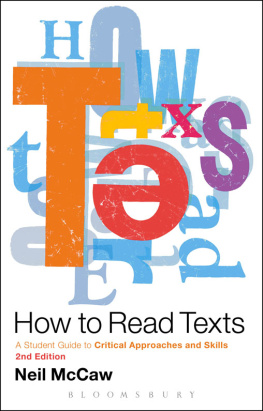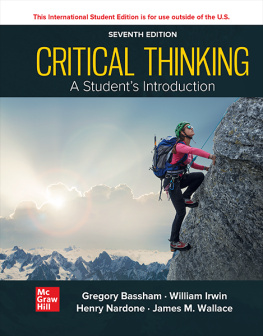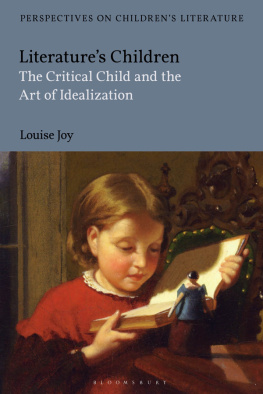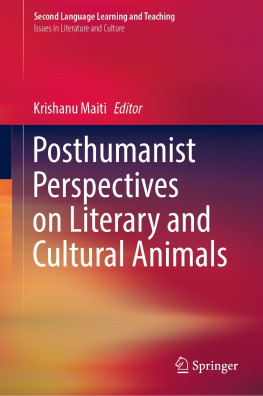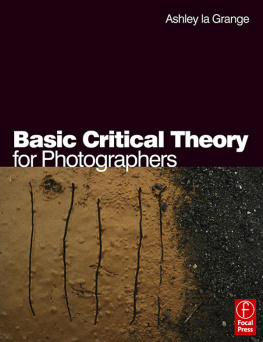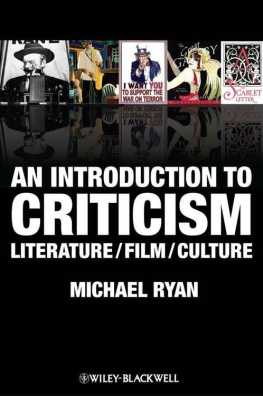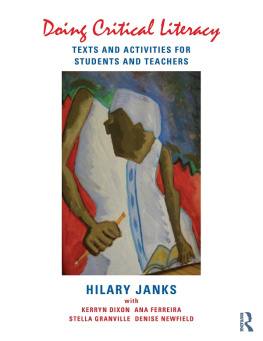Also Available from Bloomsbury
Key Terms in Literary Theory , Mary Klages
Literary Theory: A Guide for the Perplexed, Mary Klages
Modern Literary Theory: A Reader , Edited by Patricia Waugh and Philip Rice
Studying English Literature , Edited by Ashley Chantler and David Higgins
Studying Film , Nathan Abrams, Ian Bell and Jan Udris
Studying Literature , Paul Goring, Jeremy Hawthorn and Domhnall Mitchell
Studying the Novel , Jeremy Hawthorn
Studying Plays , Simon Shepherd and Nick Wallis
Studying Poetry , Stephen Matterson and Darryl Jones
How to
Read Texts
A Student Guide to
Critical Approaches
and Skills
2nd Edition
Neil McCaw

Bloomsbury Academic
An imprint of Bloomsbury Publishing Plc
50 Bedford Square | 1385 Broadway |
London | New York |
WC1B 3DP | NY 10018 |
UK | USA |
www.bloomsbury.com
First published 2008 by Continuum
This Second edition Neil McCaw, 2013
All rights reserved. No part of this publication may be reproduced or transmitted in any form or by any means, electronic or mechanical, including photocopying, recording, or any information storage or retrieval system, without prior permission in writing from the publishers.
Neil McCaw has asserted his right under the Copyright, Designs and Patents Act, 1988, to be identified as Author of this work.
No responsibility for loss caused to any individual or organization acting on or refraining from action as a result of the material in this publication can be accepted by Bloomsbury Academic or the author.
British Library Cataloguing-in-Publication Data
A catalogue record for this book is available from the British Library.
ISBN: 978-1-4411-4222-1
Library of Congress Cataloging-in-Publication Data
A catalog record for this book is available from the Library of Congress.
Typeset by Fakenham Prepress Solutions, Fakenham, Norfolk NR21 8NN
For the McCaws, past, present and future
Contents
We have probably all experienced many occasions when, on returning to a piece of writing that we really, REALLY thought was our best work ever we realize that whilst we have been away some unscrupulous vandal has rewritten all of our glorious words and made them seem clumsy, awkward, stumbling, perhaps even barely comprehensible. I have that experience frequently. So, one of the main delights of being asked to write a revised edition of How to Read Texts has been the chance to rewrite, correct, improve etc. all those things that I noticed arent quite as I would have liked in the first edition. In particular, I have welcomed the opportunity to further think through my ideas on reading in light of recent critical and academic developments and also my own experience of teaching actual students. Consequently, all of the chapters have been significantly revised and reorganized, and new sections and chapters have been added to sharpen the focus. In particular:
There is an additional introductory chapter which deals in more detail with the transition from school-reader to university-reader. This comes in response to a lot of the feedback I received on the 2008 edition which said that the focus on transition from school to university was one of the main ways How to Read Texts stood out from other comparable textbooks in this area. So I decided that there was more to say on this subject to help developing students understand how and why their reading changes as their education progresses and yet how it is also important to see the continuities that exist between reading at university level and reading prior to this.
There is a development of the notion of reading as a creative pursuit.
The connections between the chapters have been made more explicit. The second edition shows how each of the different aspects of reading (textual, contextual, philosophical etc.) relate to each other through the questions we ask about texts.
Although the first edition of How to Read Texts focuses on the reading of texts its focus was on prose, poetry, and drama. This time around the focus has been expanded in order to look at cultural texts more widely, namely film, television, photography and painting.
There are new sections on genre, intertextuality and adaptation.
The second edition makes links with critical theory throughout all the chapters; further, the individual chapter on theory has been fundamentally reshaped.
Hopefully these various changes amount to improvements that will make the second edition of How to Read Texts even more of a help to those of you who want to develop as undergraduate readers in new and exciting ways.
NM January 2013
How to Read Texts would not have been possible without the many students I have taught over the past 15 years or so; they have kept me on my toes throughout, for which they have my gratitude.
Never-ending thanks go to Liz Stuart, Mick Jardine and Andrew Melrose for all their kindness when it was most needed. This book would never have been finished without their support.
Love to Tracey, Charlie and Alfie, who are always my inspiration.
Chapter summary
This introductory chapter considers the ways in which an awareness of our reading development can be part of the process of becoming a sophisticated, imaginative reader at university level. In particular it illustrates how an appreciation of the differences between the various stages of reading helps sharpen our understanding of how to approach texts within Higher Education.
You have been reading for many years; it is something you are comfortable with; it is something you (hopefully) enjoy. And you are now at university, on a course that profoundly challenges the way you read and expects you to think about reading in entirely new ways. Or at least that is how it seems. So, you might reasonably ask, how does How to Read Texts help? Is it an attempt to show you how to do something youve already been doing perfectly well all by yourself (thank you very much) for a long time? Well, no, mostly . Despite its title this book will not tell you how to do something you already know how to do; just as Arnold Bennetts How to Live on 24 Hours a Day (1910) isnt really a book about the challenges of simply existing . How to Read Texts has been written in recognition of the fact that how you have read to this point in your education is relevant to your future development. It does not ask you to start all over again, to forget what you have learnt to date, but rather to use your current knowledge and reading skills and a fine-tuned understanding of how your reading has evolved from its earliest stages, as the basis for how you move forward.
Part of this is about illustrating the links between your reflex reading (the more commonplace, uninhibited, un-self-conscious type of reading wherein the only goal is satisfaction and pleasure) and the more target-oriented forms
The aim of How to Read Texts is as such to help you harness your reading pleasure, what D. H. Lawrence rather beautifully calls the tremulations on the ether that make the whole man alive tremble, and the more goal-driven and attainment-focused type of reading within the context of university-level studies is to better understand the nature of your reading development up to this point.
From the beginning, a childs acquisition of basic literacy skills marks an important step in growing-up; they listen to words brought to life by someone else, move on to user-friendly read aloud books with gloriously-coloured pictures and pages, and their self-confidence grows as their ability to recognize words improves. Reading is part of the socialization process and books are part of an evolving conversation a child has with the world around them. Once in formal education they progress to more interactive read-aloud texts, scaffolded reading schemes, and are encouraged to ask questions, give comment, and fill in the gaps in meaning. Hopefully they will reach the stage when they happily secrete themselves in the corner of their bedrooms or other welcoming spaces and lose themselves in the tales of adventure and drama and fun that can be found in so-called chapter books, when no adult assistance is required. For those who come to love reading as a pastime this relationship with books becomes instinctive and essential.
Next page
